Activities Spanning Three Centuries
Nippon Express Company, Ltd., was established in 1937 in line with the Nippon Tsu-un Kaisha Law as a semi-government transportation enterprise. The Company was created by pooling the assets of Kokusai Tsu-un KK (International Express Co., Ltd.), which consolidated many of the nation’s small-scale rail transport companies, and six other competitors, with additional funding from the Japanese government.
As World War II progressed, the need for a centralized approach to transport deepened throughout Japan, and the government combined the transportation companies operating in all of the nation’s major cities into what would later become Nippon Express. In 1950, under the Express Business Act and the Commercial Law Act, the company was relaunched as a private concern. Since that time, Nippon Express has expanded and developed its business in tandem with the Japanese economy as a whole.
Nippon Express History
| 1872 | Riku-un Moto Kaisha is founded |
|---|---|
| 1875 | Company name changes to Naikoku Tsu-un Kabushiki Kaisha (Domestic Express Co., Ltd.) |
| 1928 | Begins operations under the name of Kokusai Tsu-un Kabushiki Kaisha (International Express Co., Ltd.) |
| 1937 | Nippon Express Company, Ltd., is established |
| 1941-45 | Nippon Express consolidates Japan’s transportation companies, and begins its modern-day operations |
| 1950 | Nippon Express goes public and is reestablished as a private company |
| 1951 | Begins experimental operation of Nittsu-style container transport Transports antiques for Ancient Art of Japan Exhibition for the first time, begins art transport operation |
| 1955 | Begins travel services and domestic air-freight forwarding |
| 1958 | Representative office opens in New York Establishes Transport History Archives (currently Museum of Logistics) |
| 1959 | Begins transport by 300-ton trailer |
| 1961 | Establishes Nippon Express Scholorship Society |
| 1962 | Nippon Express USA, Inc., is established |
| 1963 | Introduces a system to encourage employees to suggest ideas (Teian Seido) Issues $15 million worth of dollar-denominated convertible bonds in the United States Representative office opens in Seoul |
| 1964 | Freighter Dai-ichi Ten-nichi Maru connecting Tokyo and Muroran starts operation Begins marine transport operations using three-ton containers Performs services for the Olympic Games in Tokyo Transports the Venus de Milo 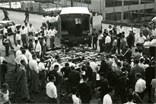 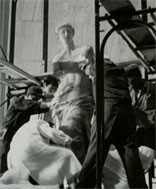 |
| 1965 | Establishes Security Transport Business Division Nittsu Gakuen and the University of Transportation Economics open |
| 1966 | Issues Japan E first convertible bonds worth¥10 billion Representative offices open in Dusseldorf, Amsterdam and Rome |
| 1967 | Representative offices open in Taipei and Sydney |
| 1968 | Representative offices open in Paris and Bangkok |
| 1969 | All offices are connected by computer |
| 1970 | Performs services for the International Exposition in Osaka Representative offices open in Singapore, Honolulu and London 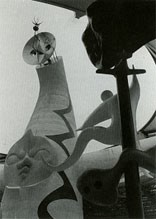 |
| 1971 | Marine transport route connecting Tokyo and Tomakomai, Hokkaido, is opened Begins operation using 10-foot, five-ton containers |
| 1972 | Performs services for the Winter Olympics in Sapporo |
| 1973 | Central Information System Center opens within the head offices Nippon Express (Singapore) Pte. Ltd., is established |
| 1974 | Transports the Mona Lisa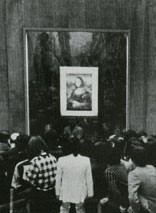 |
| 1976 | Performs services for the Marine Exposition in Okinawa |
| 1977 | Simple Pelican Box service is launched (name changed in 1981 to Pelican) |
| 1978 | Performs services for transferring New Tokyo International Airport to Narita Nippon Express Hawaii, Inc., is established |
| 1979 | Nippon Express (H.K.) Co., Ltd. and Nippon Express do Brasil Ltda., are established |
| 1980 | Regular marine transport route connecting Osaka and Tomakomai is in operation Transports statue of Ganjin to China |
| 1981 | NSG activities begin Nippon Express (U.K.) Ltd., and Nippon Express (Deutschland) GmbH are established |
| 1982 | Pelican service extended to overseas destinations Transports Moai statues from Easter Island |
| 1983 | Nippon Express (Belgium) N.V./S.A. and Nippon Express Canada Ltd. are established |
| 1984 | VAN system begins operation Construction completed for Tokyo Central Terminal for small parcels Nippon Express Tours (Europe) Ltd. and Nippon Express (Malaysia) Sdn. Bhd. are established |
| 1985 | Performs services for International Exposition in Tsukuba Nippon Express (Australia) Pty., Ltd., Nippon Express France, S.A., and Nippon Express Travel U.S.A., Inc. are established 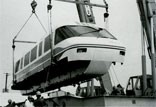 |
| 1986 | Nippon Express (Italia) S.R.L. is established |
| 1987 | Develops a quality control campaign Introduces methanol-powered vehicles Nippon Express (Schweiz) AG is established |
| 1988 | Nippon Express de Espana, S.A. is established |
| 1989 | Nippon Express’ own two-ton rail container and Singles Pack, a small-volume moving service, are launched Nippon Express (Thailand) Co., Ltd., is established |
| 1990 | Renews system to encourage employees to suggest ideas (Shin Teian Seido) Performs services for Flower and Greenery Exposition Nippon Express (New Zealand) Ltd., is established |
| 1991 | Super Pelican service is launched Corporate committee is established to address environmental issues Creates an educational video for fifth graders |
| 1992 | Introduces electric vehicles Participates in UNICEF foreign coins donation project Global network expands to more than 200 operational bases Worldwide communications network begins operation |
| 1993 | Recyclable moving/packing materials are developed Nippon Express USA establishes the Nippon Express Foundation Participates in “Ai no Pochette” charity drive to send packages to needy children around the world |
| 1994 | Shared use of trunk roads by truck transport companies begins Shanghai Express International Co., Ltd. and Nippon Express (Shenzhen) Co., Ltd., are established |
| 1995 | Nippon Express Philippines Corporation is established |
| 1996 | Full operation of integrated clerical work processing system begins Representative offices open in Hanoi and Ho Chi Minh. The office in Johannesburg reopens. |
| 1997 | Global distribution information system “N-SHATLE” is developed Pro Compo service is launched Established Eco-Business Division Transports the Buddhist statue kudara kannon to France Nippon Express (Zhuhai) Co., Ltd., Nippon Express Chile S.A., and P.T. Nittsu Lemo Indonesia Logistik are established |
| 1998 | Transports the Statue of Liberty scale model from Paris. Produces a pamphlet on distribution for elementary school students Museum of Logistics opens Representative office opens in Budapest Major organizational restructuring is practiced |
| 1999 | Transports the Liberty Guiding the People Tokyo Food Terminal is completed Full-scale operation of internet mail order delivery bigins Toll-Free Number for Parcel Collection Service begins Number of overseas employees exceeds 8,000 |
| 2000 | Izu Study & Training Center is opened Environmental report is issued Carries out moving work in accordance with the reorganization of government ministries and agencies |
| 2002 | Carried out transportation work related to the hosting of the FIFA World Cup soccer tournament Number of low-pollution vehicles introduced exceeded 1,000 |
| 2003 | “Ecology Konpo” home removal product launched Inaugural Nittsu Group Nationwide Contest for Drivers and Forklift Operators Compliance Department established |
| 2004 | New corpolate slogan,”With Your Life”, announced New IT system commenced operation Digital tachoglaph installed in sales vehicles throughout the Group |
| 2005 | Performed services for”Expo2005 Aichi,Japan” New Pelican”Delivery Time Frame Specification”service began 20th anniversary of the Nittsu Family Concert |
| 2006 | Nippon Express(St.Petersburg) LLC established. Transported the giant mural “the Myth of tomorrow”,painted by Taro Okamoto. “Eco-Recycle Express”and “Eco-Recycle Box” sale launched. Ecology Konpo service recieves “Eco Products Award” the Minister’s Award from the Ministry of Land,Infrastracture and Transport. |


